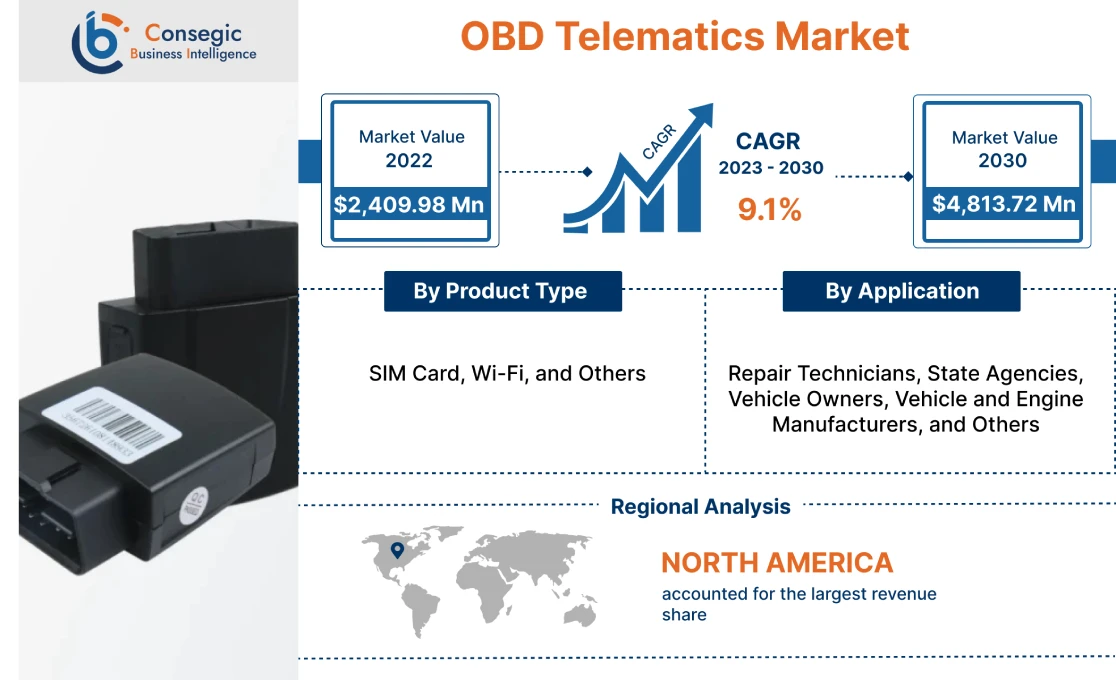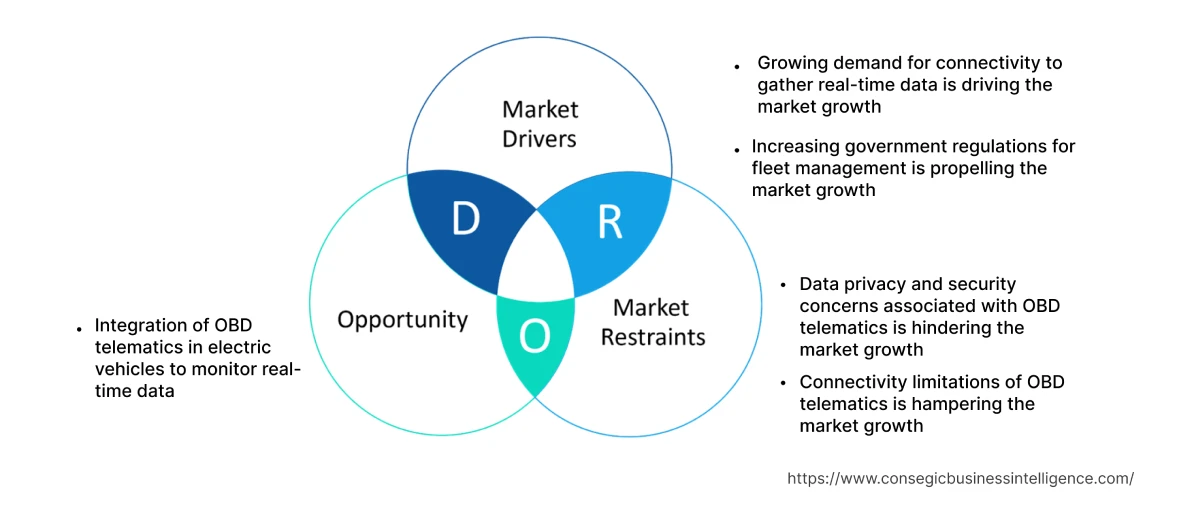OBD Telematics Market Introduction :
OBD Telematics Market size is estimated to reach over USD 4,813.72 Million by 2030 from a value of USD 2,409.98 Million in 2022, growing at a CAGR of 9.1% from 2023 to 2030.
OBD Telematics Market Definition & Overview :
OBD Telematics (On-Board Diagnostics Telematics) refers to the combination of vehicle diagnostics and telematics technology. Telematics is a modern system that combines telecommunications and informatics to manage data remotely over long distances. Vehicle telematics employs technology such as GPS sensors and onboard diagnostic codes to acquire driver behavior, fleet data, engine diagnostics, location and activity. This involves using an OBD-II (On-Board Diagnostics-II) scanner that connects to the OBD-II port in a vehicle. The vehicle-related data is then collected and transmitted wirelessly to a server or a cloud-based platform. Telematics analyzes the collected data and provides the necessary information to the driver.
OBD Telematics Market Insights :
OBD Telematics Market Dynamics - (DRO) :
Key Drivers :
Growing demand for connectivity to gather real-time data is driving the market growth
The growing demand for connected vehicles due to the integration of telematics systems into vehicle designs has contributed to the expansion of the OBD telematics market. Modern vehicles are equipped with built-in OBD-II ports and allow fleet management software to connect and receive live vehicle data. Consequently, based on the analysis this telematics captures information such as location, speed, and real-time location of the vehicles. Moreover, they provide navigation assistance to guide drivers to reach their locations. For instance, in November 2022, ATrack Technology Inc. launched 4G fleet management products called AX300 OBD tracker and AK500 telematics gateway to improve management efficiency and reduce operating costs. Therefore, they play a crucial role in gathering vehicle-related information, boosting the market.
Increasing government regulations for fleet management is propelling the market
Government regulations and standards related to vehicle emissions, safety, and efficiency have played a significant role in driving the adoption of OBD telematics. Many countries have implemented regulations that mandate the use of OBD systems in vehicles, creating a market demand for these solutions. The integration of these in vehicles allow governments to improve their transportation systems by analyzing vehicle-generated data. For instance, in June 2022, The U.S. General Services Administration Fleet team activated approximately 19,000 new telematics devices to receive, send, and store data connected with fleet vehicles. Therefore, the application of telematics to determine the operational efficiency of a variety of vehicles is accelerating the OBD telematics market.
Key Restraints :
Data privacy and security concerns associated with OBD telematics is hindering the market growth
OBD telematics systems, while valuable for vehicle transmission and tracking pose several security threats. The collection and transmission of vehicle-generated data raises concerns about privacy and security of data. These threats include the possibility of data breaches, illegal access to private cars and owners data, and wrong use of gathered data fir surveillance purpose. These systems gather sensitive information, including vehicle location, driving behavior, and diagnostics. The information is used by the insurance companies, mechanics, and other authorities that raises data privacy concerns among consumers. Therefore, the security concerns associated with these telematics is hindering the market.
Connectivity limitations of OBD telematics is hampering the market
OBD telematics systems rely on reliable and continuous connectivity to transmit data. However, in remote areas or regions with poor network coverage, connectivity limitations impact the effectiveness of real-time data monitoring and communication with the telematics platform. Thus, the increased dependence of these on constant network connectivity for efficient operations is restraining the market.
Future Opportunities :
Integration of OBD telematics in electric vehicles to monitor real-time data
The integration of these in electric vehicles is expected to create numerous opportunities for the OBD telematics market during the forecast period. These telematics provide real-time data on battery health, charging status, range estimation, and energy efficiency, thereby allowing EV owners to optimize their driving and charging patterns. For instance, in August 2022, Lightning eMotors launched Lightning Insights for monitoring and managing lightning fleet assets in electric vehicles. Therefore, the incorporation of telematics in electric vehicles to monitor and manage EV-specific data is expected to provide lucrative trends and OBD telematics market opportunities during the forecast period.
OBD Telematics Market Report Insights :
| Report Attributes | Report Details |
| Study Timeline | 2017-2030 |
| Market Size in 2030 | USD 4,813.72 Million |
| CAGR (2023-2030) | 9.1% |
| Based on the Product Type | SIM Card, Wi-Fi, and Others |
| Based on the Application | Repair Technicians, State Agencies, Vehicle Owners, Vehicle and Engine Manufacturers, and Others |
| Based on the Region | North America, Europe, Asia-Pacific, Latin America, Middle East & Africa |
| Key Players | BorgWarner Inc., Continental AG, Bosch Automotive Service Solutions Inc., LG Electronics, Geotab Inc., Danlaw, Inc., CalAmp, Xirgo Technologies, Mojio, Autonet |
OBD Telematics Market Segmental Analysis :
Based on the Product Type :
Based on the product type, the market is bifurcated into SIM card, Wi-Fi, and others. SIM card segment accounted for the largest revenue share of 67.65% in the year 2022. SIM cards are widely utilized by vehicle manufacturers to establish a cellular connection for data transmission. As per analysis, SIM cards are installed as a part of infotainment system that provides advanced features such as telematics systems, in-car navigation, and GPS tracking systems. As a result, SIM card-based connectivity offers broad coverage and reliable connectivity, allowing real-time data monitoring and communication with the telematics platform.
The Wi-Fi segment is expected to witness fastest CAGR during the forecast period. These devices utilize Wi-Fi technology to establish a wireless connection between devices. Wi-Fi-based connectivity is useful for applications where personal data access and transfer are prioritized, such as in-vehicle entertainment, passenger connectivity, or vehicle diagnostics for personal use. For instance, in January 2021, Geotab Inc. launched GO9+ telematics solution featuring W-Fi connectivity to provide improved acceleration tracking and GPS tracking. Moreover, the ability of Wi-Fi-based telematics to transfer data between connected devices such as smartphones, tablets, and other onboard systems is accelerating the market.
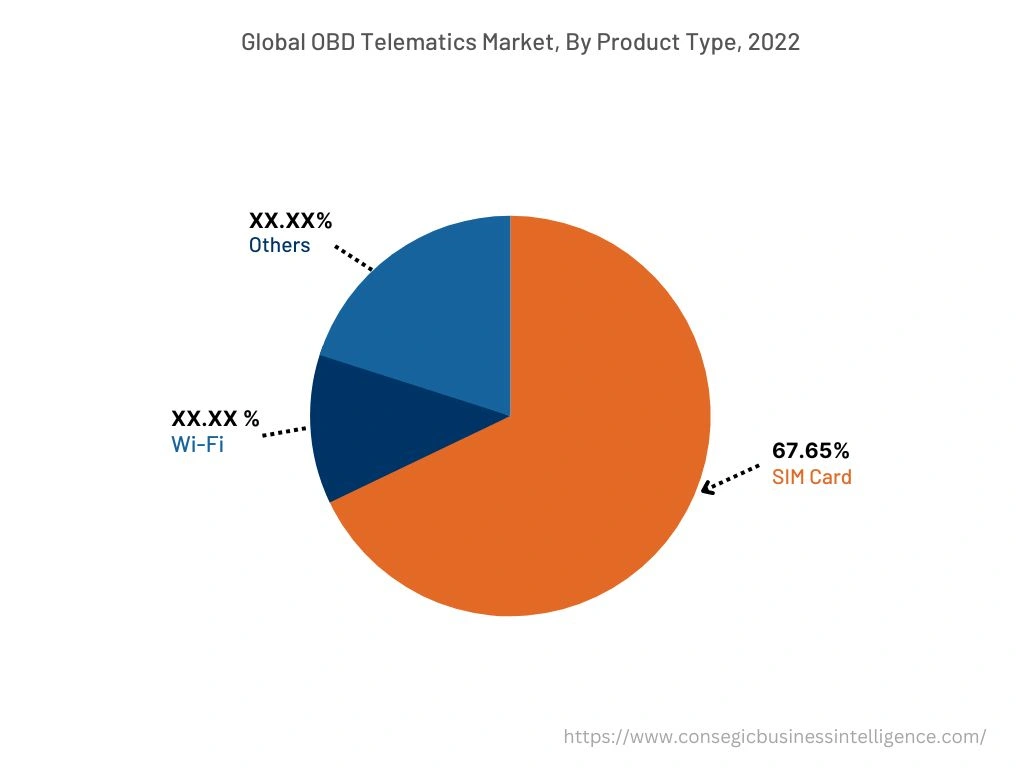
Based on the Application :
Based on the application, the market is separated into repair technicians, state agencies, vehicle owners, vehicle and engine manufacturers, and others. The repair technicians segment accounted for the largest revenue share in the year 2022. These devices provide valuable information to repair technicians, enabling them to diagnose vehicle issues accurately and efficiently. These assists technicians in identifying faults in vehicles by monitoring vehicle performance parameters. Consequently, the increasing adoption of these by repair technicians and service centers to detect faults in vehicles is propelling the market.
The state agencies segment is anticipated to witness the fastest CAGR during the forecast period. These telematics helps state agencies to track emissions from vehicles and identify vehicles that require inspection or maintenance. They improve air quality by identifying cars and trucks with high emissions that require repair and maintenance. Thus, they allow state agencies to enforce environmental regulations, boosting the OBD telematics market growth.
Based on the Region :
The regional segment includes North America, Europe, Asia Pacific, Middle East and Africa, and Latin America.
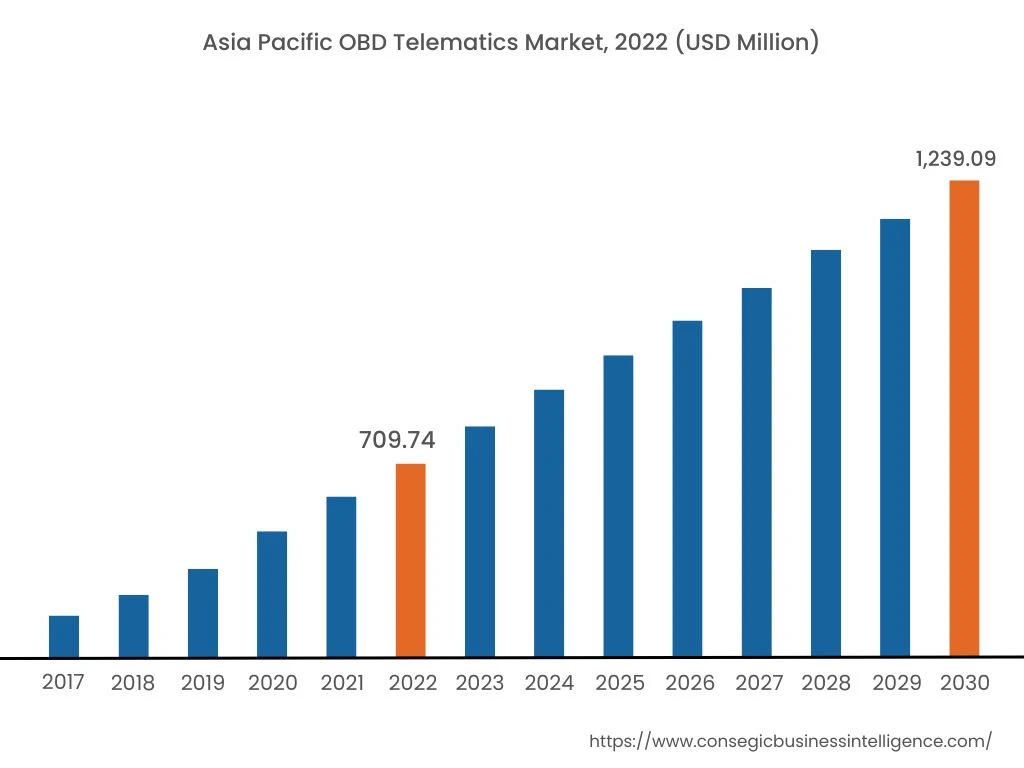
North America accounted for the largest revenue share in the year 2022. The early adoption of advanced technologies including, data analytics, connectivity services to monitor the data generated by vehicles, and various other trends are driving the market. Based on the analysis these telematics provide real-time information of various parameters such as driver behavior, fleet data, engine diagnostics, location, and activity of the vehicle. For instance, in August 2020, Teletrac Navman US Ltd. launched next generation AI-Based Real-time, predictive telematics solution called TN360 allowing businesses to improve efficiency of logistic workflows, driver behavior, compliance and fuel management processes. Moreover, increasing environmental regulations by the state agencies to improve air quality is driving the demand for these solutions to monitor various parameters such as emissions from the vehicle.
The Asia-Pacific region accounted for an OBD telematics market share of USD 709.74 million in 2022 and is expected to reach USD 1,239.09 million in 2030, registering a CAGR of 9.3% during the forecast period. Additionally, in the region, Japan accounted for the largest revenue share of 24.6% in the year 2022. The growing automotive industry in the Asia-Pacific is driving the OBD telematics market demand and trends in the region. Consumers are increasingly adopting vehicles for in-vehicle entertainment and data transfer applications. Moreover, as per the OBD telematics market analysis, the presence of key players such as Honda, LG Electronics, and Queclink Wireless Solutions Co., Ltd. in the region is accelerating the growth of the market.
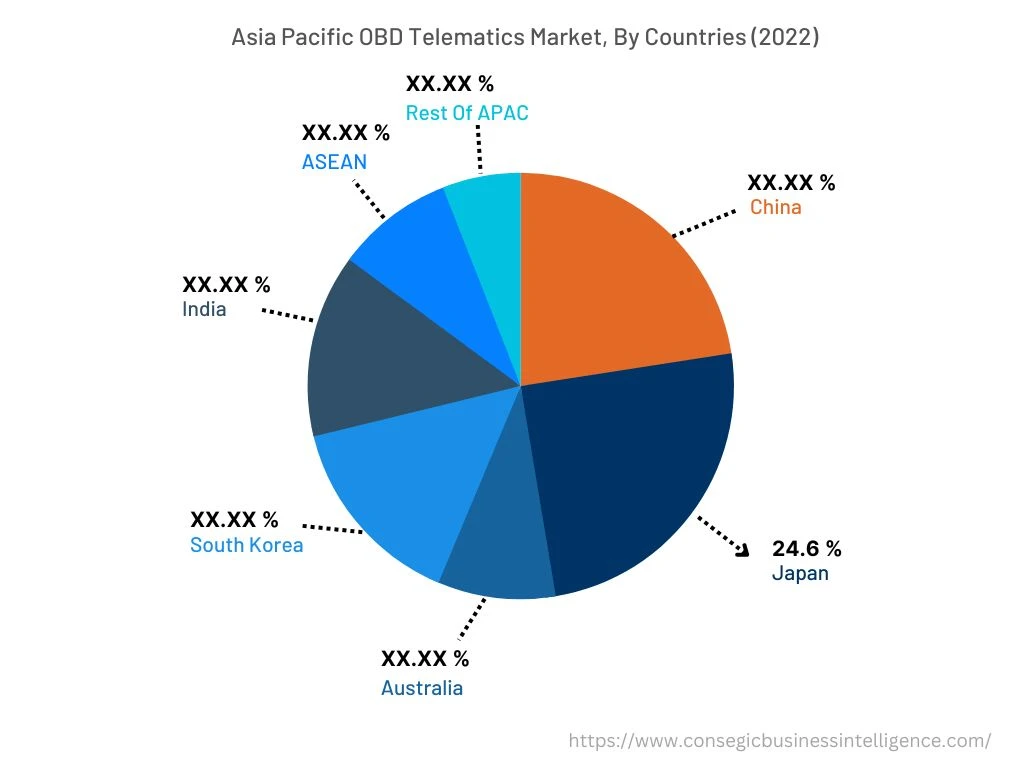
Top Key Players & Market Share Insights :
The OBD Telematics market trend is characterized by the presence of major players providing these telematics solutions for the domestic and international markets. Key players are adopting various business strategies such as product innovation, research and development (R&D), and application launches that accelerate the expansion of the OBD telematics industry. Key players in the market include-
- BorgWarner Inc.
- Continental AG
- Mojio
- Queclink Wireless Solutions Co., Ltd.
- Bosch Automotive Service Solutions Inc.
- LG Electronics
- Geotab Inc.
- Danlaw, Inc.
- CalAmp
- Xirgo Technologies
Recent Industry Developments :
- In February 2023, Cummins Group collaborated with Automotive Research Association of India to perform Bharat Stage-VI OBD-II emission standard compliance certification tests.
- In March 2023, Honda launched OBD2 compliant Activa125 featuring Enhanced Smart Power (eSP) to optimize energy output by the vehicle.
Key Questions Answered in the Report
What is OBD Telematics? +
OBD Telematics is a system that combines telecommunications and informatics to manage vehicle-generated data remotely over long distances. OBD Telematics provides information based on vehicle speed, mileage, and emission by the vehicle.
What specific segmentation details are covered in the OBD telematics report, and how is the dominating segment impacting the market growth? +
By product type has witnessed SIM Card as the dominating segment in the year 2022, due to its ability to establish a cellular connection for data transmission.
What specific segmentation details are covered in the OBD telematics market report, and how is the fastest segment anticipated to impact the market growth? +
Each segment is projected to have the fastest-growing sub-segment being fuelled by industry trends and drivers. For instance, by application segment has witnessed state agencies as the fastest-growing segment during the forecast period as they deploy OBD telematics to check the air quality.
Which region/country is anticipated to witness the highest CAGR during the forecast period, 2023-2030? +
Asia-Pacific region is expected to register fastest CAGR growth during the forecast period due to the increasing adoption of automotive vehicles in the region.
